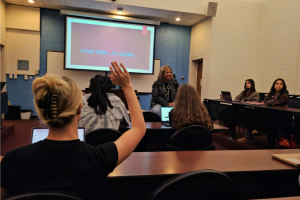New PR course prepares students for celebrity public relations

Story by Hannah Rosenberger '24
Photo by Jessica Simmons '24 (M.A.)
The students in Professor of the Practice Jules Dixon-Green's upper-level public relations classes spent much of the past year asking her to teach a class focused on celebrity and entertainment PR.
This semester, those students finally got their chance in Dixon-Green's special topics course, MEJO 490: “Entertainment/Celebrity PR.”
By spending class time examining case studies and learning strategies for how to mitigate a celebrity crisis, Dixon-Green equips students with tangible skills that will be applicable as professionals working in the entertainment sphere and beyond.
“It's not just Hollywood celebrities,” said Dixon-Green, who also serves as the school’s Associate Dean for Undergraduate Studies and Curriculum. “It's Capitol Hill celebrities, it's sports teams, which are everywhere. I found that there was a need to expose our students to very specific information in that space.”
As someone who spent decades working with massive international brands like McDonald’s, on press junkets for celebrities like Beyoncé, and in senior communications roles centered on talent recruitment, Dixon-Green knows that no textbook or lecture alone is going to adequately prepare a young publicist for entering the field — especially a subfield as dynamic and chaotic as the celebrity and entertainment industry.
With that in mind, Dixon-Green has framed her MEJO 490 class around providing students with practical experience using real-world scenarios — such as developing a strategy to media train Olivia Rodrigo for the Video Music Awards or roleplaying what they would do as the lead communications coordinator for the NFL to manage the PR around Taylor Swift’s and Travis Kelce’s relationship.
Dixon-Green devoted so much class time to analyzing that last scenario that she ended up reframing her syllabus to allow students to dive deeper into what has become the perfect case study. “Who knew when we launched this semester that we would have such rich, amazing information to talk about?” Dixon-Green said.
In class, students divided into groups to roleplay as if they'd just come from a meeting with Travis Kelce. Each group had to report on the key takeaways from the "meeting" and share with Dixon-Green their suggestions for how the NFL should publicly approach the situation. In turn, she responded as an actual lead publicist would, asking follow-up questions and pushing everyone to participate.
Dixon-Green didn't go easy on the students in those mock meetings. The activity forced students like advertising and public relations major Morgan Kumi ’25 to think differently about how to prepare appropriately for difficult scenarios.
“Someone is going to ask the uncomfortable question,” Kumi said. “You have to have an answer for it as a publicist — not everything is going to be peaches and roses.”
That's especially true in celebrity public relations, where publicists work more one-on-one with someone to build a personal brand. Dixon-Green says celebrity publicists need to be quick thinking, as one person's decisions can send everything into crisis communication instantaneously.
For advertising and public relations major Jaden Esquivel ’25, that's what distinguishes this field from other types of public relations — and why she finds Dixon-Green's class so important.
“The way you have to strategize and think and communicate just all depends on the person that you're working with and what the client really wants,” Esquivel said. "And one thing I've learned so far within the class is just how important it is to make those connections.”
The need for those tangible skills that Dixon-Green has emphasized in her syllabus holds true regardless of what segment of public relations her students will land in.
They have spent class time talking about everything from the world of music to sports communication to the tourism and travel industries, with an emphasis on applying the knowledge they've learned throughout this semester and in other PR basics courses like “Public Relations Writing.”
“You take the case studies class, and you take the fundamentals of Ad/PR class or any of the courses in which you learn the basics — you're getting textbook definitions, you're taking quizzes, you're learning the actual lingo,” said Macy Brown ’24, an advertising and public relations major. “In this class, you're actually executing it, you're talking about it, and I think that's what makes it really unique.”
As students like Kumi, Esquivel and Brown demonstrate, there is demand for a class with that level of experiential and specific knowledge. As Kumi put it, celebrity public relations is often what people think of when they think of public relations.
That’s why Dixon-Green hopes to keep teaching and refining the course in semesters to come.
“It's unbelievable to be able to learn firsthand how to work with people and celebrities and spaces like that,” Dixon-Green said. “I feel it’s a really enthusiastic responsibility of mine to deliver that to our students who have a desire to learn more about that space.”